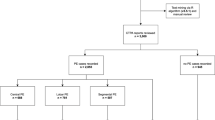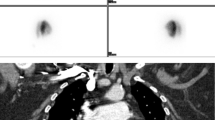Abstract
The purpose of our study was to assess feasibility, safety and clinical utility of selective pulmonary angiography in patients with suspected pulmonary embolism and a nondiagnostic lung scan. The design was a prospective, descriptive study. The subjects were consecutive patients with clinically suspected pulmonary embolism and a nondiagnostic lung scintigram in whom pulmonary angiography was considered. Angiography was withheld in cases of manifest heart failure, renal failure, mean pulmonary artery pressure above 40 mmHg, or if there were compelling clinical reasons. All patients were followed-up for 6 months. The outcome measures were successful angiography, morbidity, mortality and recurrent pulmonary embolism in patients with normal angiogram in whom anticoagulants were withheld during 6 months of follow-up. Of 487 patients, 196 (40 %) had nondiagnostic lung scan findings. In 46 patients (23 %) pulmonary angiography was withheld. Pulmonary embolism was excluded in 105 patients (70 %), and proven in 40 (27 %) patients. In 5 (3 %) patients the angiogram was inadequate for interpretation. No fatal complications were encountered [95% confidence interval (CI) 0–2.4%]. Nonfatal complications occured in 3 patients (2%; 95% CI 0–3.4%). Pulmonary angiography is safe, rules out pulmonary embolism in two thirds of patients with a nondiagnostic lung scan and can be performed in almost 80% of these patients. It is safe to withhold long-term anticoagulants if a normal angiogram is obtained in this subgroup of patients with clinically suspected pulmonary embolism.
Similar content being viewed by others
References
Hull RD, Hirsh J, Carter CJ et al. (1985) Diagnostic value of ventilation-perfusion lung scanning in patients with suspected pulmonary embolism. Chest 88: 819–828
PIOPED (1990) Value of the ventilation-perfusion scan in acute pulmonary embolism: results of the Prospective Investigation of Pulmonary Embolism Diagnosis (PIOPED). JAMA 263: 2753–2759
Stein PD, Hull RD, Saltman HA, Pineo G (1993) Strategy for diagnosis of patients with suspected acute pulmonary embolism. Chest 103: 1553–1559
McBride K, LaMorte WW, Menzoian JO (1986) Can ventilation-perfusion scans accurately diagnose acute pulmonary embolism? Arch Surg 121: 754–757
Morrell NW, Seed WA (1992) Diagnosing pulmonary embolism. Br Med J 304: 1126–1127
Dalen JE, Brooks HL, Johnson LW et al. (1971) Pulmonary angiography in acute pulmonary embolism: indications, techniques, and results in 367 patients. Am Heart J 81: 175–185
Mills SR, Jackson DC, Older RA et al. (1980) The incidence, etioligies, and avoidance of complications of pulmonary angiography in a large series. Radiology 136: 295–299
Stein PD, Althanasoulis C, Alavi A et al. (1992) Complications and validity of pulmonary angiography in acute pulmonary embolism. Circulation 85: 462–468
Hull R, Hirsh J, Carter C et al. (1983) Pulmonary angiography, ventilation lung scanning, and venography for clinically suspected pulmonary embolism with abnormal perfusion lung scan. Ann Intern Med 98: 891–899
Hull RD, Raskob GE, Ginsberg JS et al. (1994) A non-invasive strategy for the treatment of patients with suspected pulmonary embolism. Arch Intern Med 154: 289–297
Kelley MA, Carson JL, Palevsky HI, Schwartz JS (1991) Diagnosing pulmonary embolism: new facts and strategies. Ann Intern Med 114: 300–306
Oudkerk M, Beek EJR van, Putten WLJ van, Büller HR (1993) Cost-effectiveness analysis of various strategies in the diagnostic management of pulmonary embolism. Arch Intern Med 153: 947–954
Nicod P, Peterson K, Levine M et al. (1987) Pulmonary angiography in sever chronic pulmonary hypertension. Ann Intern Med 107: 565–568
Beek EJR van, Büller HR, Branjes DPM, Rutten GCFM, Cate JW den (1994) Diagnosis of clinically suspected pulmonary embolism: a survey of current practice in a teaching hospital. Neth J Med 44: 50–55
Hull RD, Raskob GE (1991) Low-probability lung scan findings: a need for change. Ann Intern Med 114: 142–143
Lensing AWA, Prandoni P, Brandjes DPM et al. (1989) Accurate detection of deep-vein thrombosis by real-time B-mode ultrasonography. N Engl J Med 320: 342–345
Bookstein JJ (1969) Segmental arteriography in pulmonary embolism. Radiology 93: 1007–1012
Perlmutt LM, Braun SD, Newman GE, Oke JE, Dunnick NR (1987) Pulmonary arteriography in the high-risk patient. Radiology 162: 187–189
Perlmutt MN, Hirsh J, Landefeld S, Raskob G (1992) Hemorrhagic complications of anticoagulant treatment. Chest 102: 352S-363S
Fihn SD, McDonnell M, Martin D et al. (1993) Risk factors for complications of chronic anticoagulation. A multicenter study. Ann Intern Med 118: 511–520
Landefeld CS, McGuire E III, Rosenblatt MW (1990) A bleeding risk index for estimating the probability of major bleeding in hospitalized patients starting anticoagulant therapy. Am J Med 89: 569–578
Novelline RA, Baltarowich OH, Atthanasoulis CA et al. (1978) The clinical course of patients with suspected pulmonary embolism and a negative pulmonary arteriogram. Radiology 126: 561–567
Quinn MF, Lundell CJ, Klotz TA et al. (1987) Reliability of selective pulmonary arteriography in the diagnosis of pulmonary embolism. Am J Radiol 149: 469–471
Van Rooij WJJ, Heeten GJ den, Sluzewski M (1995) Pulmonary embolism: diagnosis in 211 patients with use of selective pulmonary digital subtraction angiography with a flow-directed catheter. Radiology 195: 793–797
Henry JW, Relyea B, Stein PD (1995) Continuing risk of thromboemboli among patients with normal pulmonary angiograms. Chest 107: 1375–1378
Author information
Authors and Affiliations
Additional information
Correspondence to: E. J. R. van Beek
Rights and permissions
About this article
Cite this article
van Beek, E.J.R., Reekers, J.A., Batchelor, D.A. et al. Feasibility, safety and clinical utility of angiography in patients with suspected pulmonary embolism. Eur. Radiol. 6, 415–419 (1996). https://doi.org/10.1007/BF00182453
Received:
Revised:
Accepted:
Issue Date:
DOI: https://doi.org/10.1007/BF00182453




